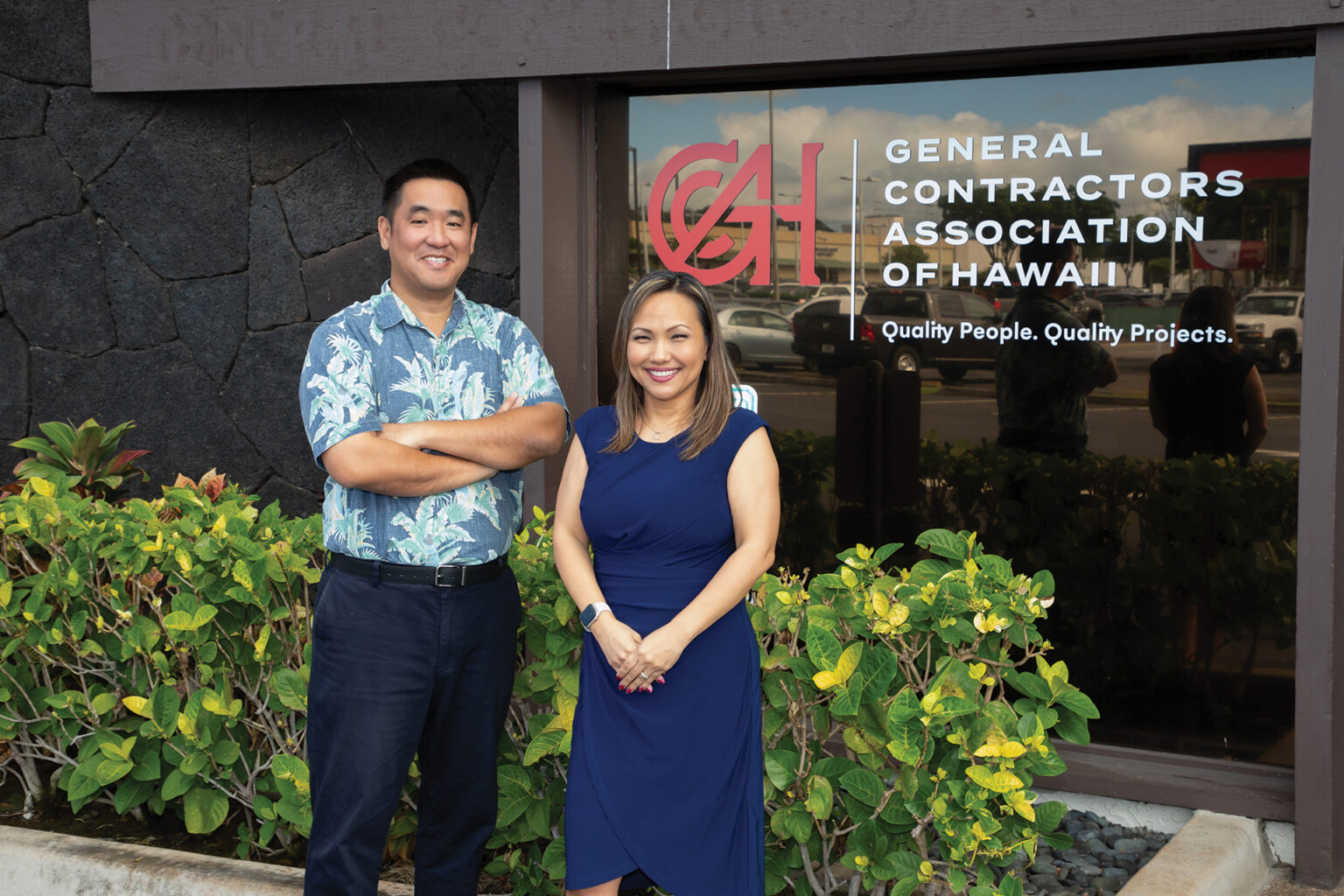Hawai‘i construction is poised for a banner year in 2024, with four new Kaka‘ako towers and the $2.8 billion Pearl Harbor dry dock project underway or on the drawing board.
In addition, record levels of federal funding for new infrastructure projects are on the way. And as reported in Building Industry Hawaii’s 2024 Construction Preview, the total value of county building permits from November 2022 to October 2023 increased 17.8 percent over the same 12-month period a year earlier.
Yet Hawai‘i contractors — who should already be seeing significant upticks in revenue — are scrambling for workers.
“More work is great, but finding those who are qualified for these jobs is not easy,” explains Michael Young, General Contractors Association (GCA) of Hawaii 2024 president. “For example, the Pearl Harbor Naval Shipyard dry dock project is estimated to create 2,500 new jobs over the construction period.
“These are quality jobs, but if there aren’t any Hawai‘i residents to meet the demand, it means these contractors have no option but to recruit from the U.S. mainland. One of our ongoing challenges this year, as in previous years, is the lack of qualified individuals to fill vital roles in our industry.”
With the recent completion of GCA’s 2024-2026 strategic plan, he says, two new GCA workforce training initiatives are underway.
WORKFORCE INITIATIVES
“We are evolving our BreakingGround 808 program into a teacher externship program in partnership with the Hawai‘i Department of Education,” Young says. “Our goal is to inspire teachers about the construction industry and give them real-world curricula they can use with their students.
“GCA member companies will have an opportunity to work directly with schools that have building and construction tracks or want to promote construction as a career path for their students.”
GCA is also backing new academic degrees to meet the growing demand for skilled construction project managers.
“We’re working with Hawai‘i Pacific University to develop a new master’s degree program in construction management, which will launch this year,” Young says. “This will be another way to develop local talent for the construction industry.”
In the short term, he notes, “we are offering more training classes for GCA members to expand their skills.
“For example, we’re tapping into the other affiliates such as the Associated General Contractors of Colorado for their training on project engineering and field engineering. It’s a great way to leverage our connection with other AGC chapters to enhance the knowledge of Hawai‘i’s workforce.”
A CALL TO ACTION
New GCA workforce and other industry initiatives arise as members share ideas and take action in committees.
“During my term as president, I would like to encourage more GCA members to make the time to be involved in a GCA committee,” Young says. “Committees are where competitors can come together to collaborate and help each other in the spirit of aloha and look after each other to elevate our industry.”
Committee participation improves project outcomes, too.
“I can personally attest to the value of GCA committees and their role in supporting major state, federal and military projects,” Young adds. “Our committees provide venues for conversations that are mutually beneficial for both GCA members and government agencies or military branches.”
Eight different GCA committees provide members with opportunities to interact directly with government project owners. During meetings, “there are candid discussions on procurement, specifications and other challenges, and they collaborate on developing breakthrough solutions together,” Young says.
“Productive conversations have taken place in our Board of Water Supply, City and County, Department of Accounting and General Services (DAGS), Department of Education, NAVFAC, Hawaii Department of Transportation, U.S. Army Corps of Engineers and University of Hawai‘i committees,” he says.
GCA committees also offer mentorship — crucial to workforce development and members’ professional growth.
“Cultivating the next generation of construction professionals is important for the future of Hawai‘i’s construction industry,” says Young. “Without qualified individuals to take the helm and lead the industry, the local construction industry could be hampered, and this could impact economic development in our islands.”
A RISING SON
Young knows firsthand just how critical mentorships can be. Michael considers Russell Young, his dad, who served as GCA president in 1999, as his primary mentor. Russell Young joined Albert C. Kobayashi Inc. (ACK), a leading Hawai‘i general contractor, in 1986 and served as president from 1994 to 2020.
Reflecting on those years in a 2020 Building Industry Hawaii interview, Russell says Michael “started from the bottom [at ACK], working as an intern since high school.”
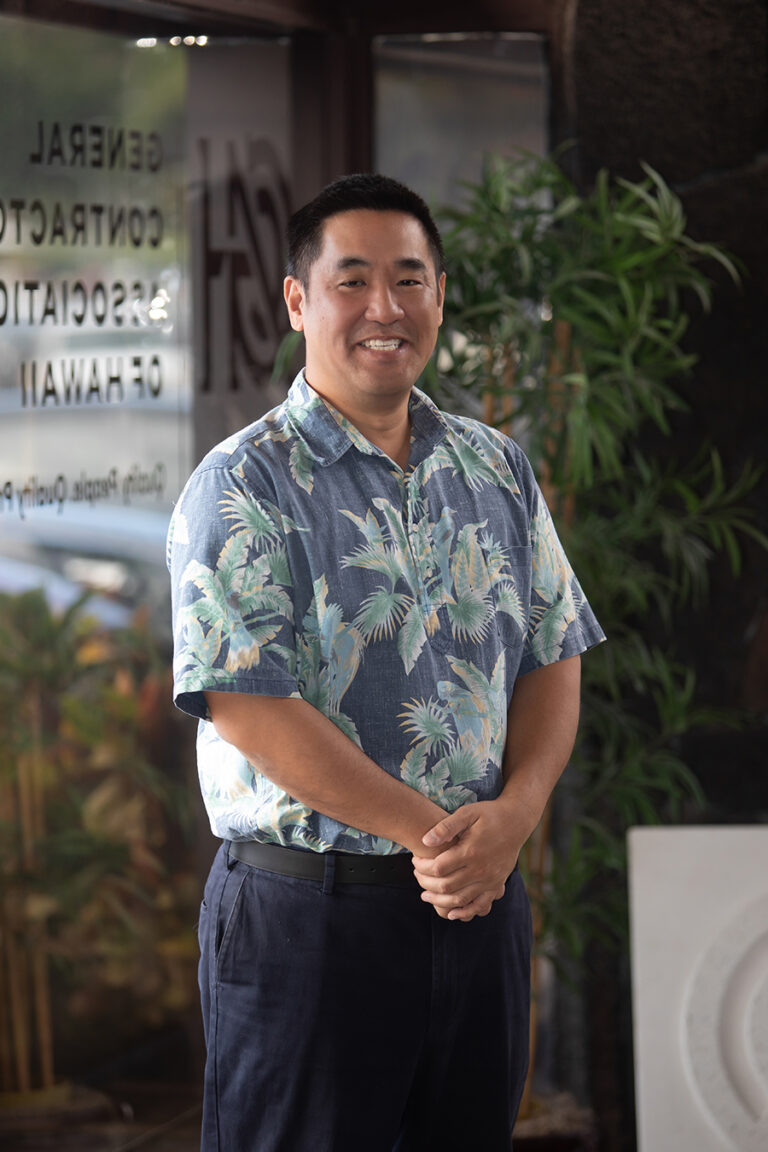
Michael Young PHOTO BY TONY GRILLO
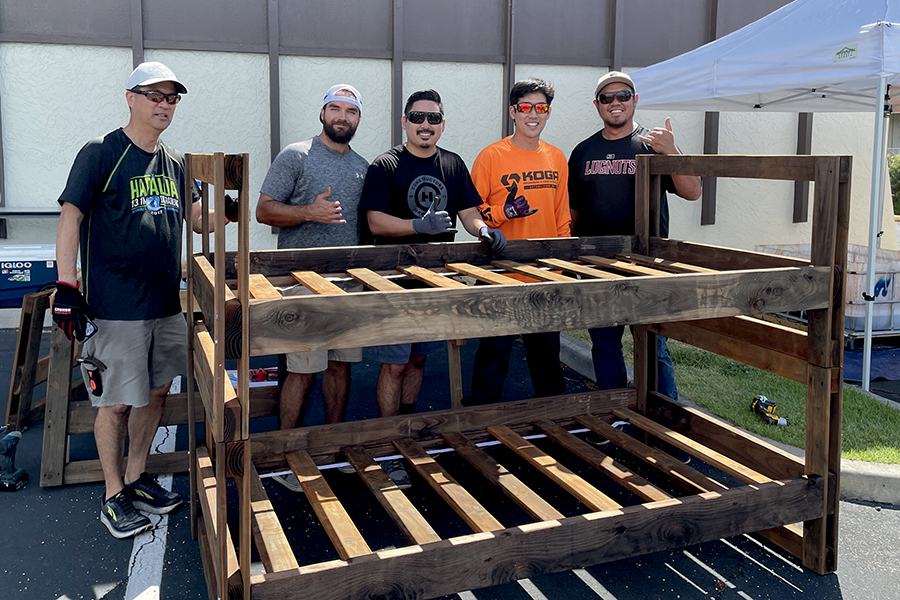
GCA’s Construction Leadership Council, along with nonprofit partner Sleep in Heavenly Peace, builds beds for those in need at the Child & Family Service office parking lot, 2023. PHOTO COURTESY GCA OF HAWAII

Birdies are on the menu for these Hawaiian Cement and Kaikor Construction Group teammates at GCA’s 2023 Scholarship Golf Tournament. The tournament funded nine scholarships for College of Engineering students at the University of Hawai‘i at Mānoa. PHOTO COURTESY GCA OF HAWAII
As his son’s mentor, Russell imparted many valuable lessons, including “no matter what, always finish the job.” Michael took heed, honing his construction skills at MIT where he graduated in 2005 with degrees in civil engineering and economics. He interned at ACK again that summer and worked on Hokua, ACK’s first luxury condominium project.
Michael joined ACK full-time in 2006, working at Ward Village Shops, transitioned into estimating and preconstruction roles on projects such as One Ala Moana, then rose to project engineer, preconstruction manager and eventually vice president.
Following Russell’s retirement, Michael became ACK president and CEO in August 2020.
GCA of Hawaii 2024 Committee Chairs
AIA/ACECH/GCA
Heather de la Garza
(Albert C. Kobayashi Inc.)
Board of Water Supply
Ryan Yamamoto
(RMY Construction Inc.)
Build Hawaii Awards
Tammie Oka
(Kiewit Infrastructure West)
City & County
Racine Hee (D & C Plumbing)
Construction
Leadership Council
Travis Higa
(Constructors Hawaii Inc.)
DAGS
Mark Tagami
(Ralph S. Inouye Co. Ltd.)
DOE
Dale Yoneda (S & M Sakamoto Inc.)
Environment
Gordon Scruton
(Unlimited Construction Services Inc.)
Finance
Mike Venezia (Hensel Phelps)
Hawaiian Electric
Glen Kaneshige
(Nordic PCL Construction Inc.)
Human Resources
Karena Tigrett
(Healy Tibbitts Builders Inc.)
Legislative
Gregg Ichimura
(Koga Engineering & Construction Inc.)
Programs & Training
Colleen Furuya
(Mass Electric Construction Co.)
Safety
Thomas Jacobs
(Layton Construction Co. LLC)
DOT
Colin Ching (Hawaiian Dredging Construction Company Inc.)
Subcontractor Council
Jackson Cheng
(Dorvin D. Leis Co. Inc.)
U.S. Corps of Engineers
Elton Au
(Nordic PCL Construction Inc.)
U.S. Navy
Steve Reid (Su-Mo Builders Inc.)
University of Hawaii
Andrew Fernandez
(Nordic PCL Construction Inc.)
Workforce Development
George Denise (Swinerton Builders)
2024 LEGISLATIVE PRIORITIES
With the convening of Hawai‘i’s 2024 legislative session in January, “the GCA Legislative Committee has been busy reviewing and monitoring all legislative measures that affect the construction industry,” says Cheryl Walthall, GCA executive director.
“We support legislation that promotes an equitable business climate and oppose efforts that attempt to unreasonably raise the cost of construction and other harmful bills. GCA is proactively introducing legislation of its own to increase procurement transparency by requiring cash or protest bonds for administrative appeals to be returned to the initiating parties, minus administrative costs, except in cases where the appeal was frivolous or made in bad faith. This will bring the state into alignment with all other states that require cash or protest bonds for administrative appeals,” she says.
Walthall says GCA does not support a bill being reintroduced this year that requires unionized stevedore company workers to dock all vessels and barges delivering products to Hawai‘i or interisland. Since shipping companies currently use their own trained personnel, “the bill would unnecessarily add to the costs of shipping, and this will translate into even higher prices for building supplies and materials,” she explains.
“This will place a financial burden on Maui, which already faces high shipping costs for building materials, including those that will be used to build temporary and permanent housing for those who have been displaced by the wildfires.
“We anticipate environmental clean-up and remediation on Maui will continue through 2024 to pave the way for infrastructure repair and replacement. We stand ready to share our expertise when the community is ready to begin the rebuilding process,” says Walthall.
A GREEN PATH FORWARD
Remediating Maui may be the most dramatic example, but “as general contractors, we know we can influence our built environment,” Young says.
“I had the privilege of participating in shaping our 2024-2026 strategic plan, and I’m proud that our association formally adopted a stronger commitment to environmental responsibility. Our strategic plan calls for us as an industry to be proactive about our industry’s role in environmental, sustainability and resiliency issues.
“The GCA will collaborate with other agencies and organizations to develop climate policies that benefit the industry and our state, and ensure we develop corresponding actions for GCA members to minimize our carbon footprint,” says Young.
Through collaboration, advocacy and leadership, “the GCA has become the trusted, leading voice of the industry,” he adds. “This did not happen by accident. GCA has been fortunate to have great officers and board members who have been committed to continually push the GCA to the next level.”
Young credits Executive Director Walthall and her team for their “excellent job of providing resources and opportunities in networking, training, continuous learning and service — all of which provide value for GCA members.”
“My hope is that GCA can continue to grow and evolve in 2024 to meet the needs of our members and the industry,” says Young.
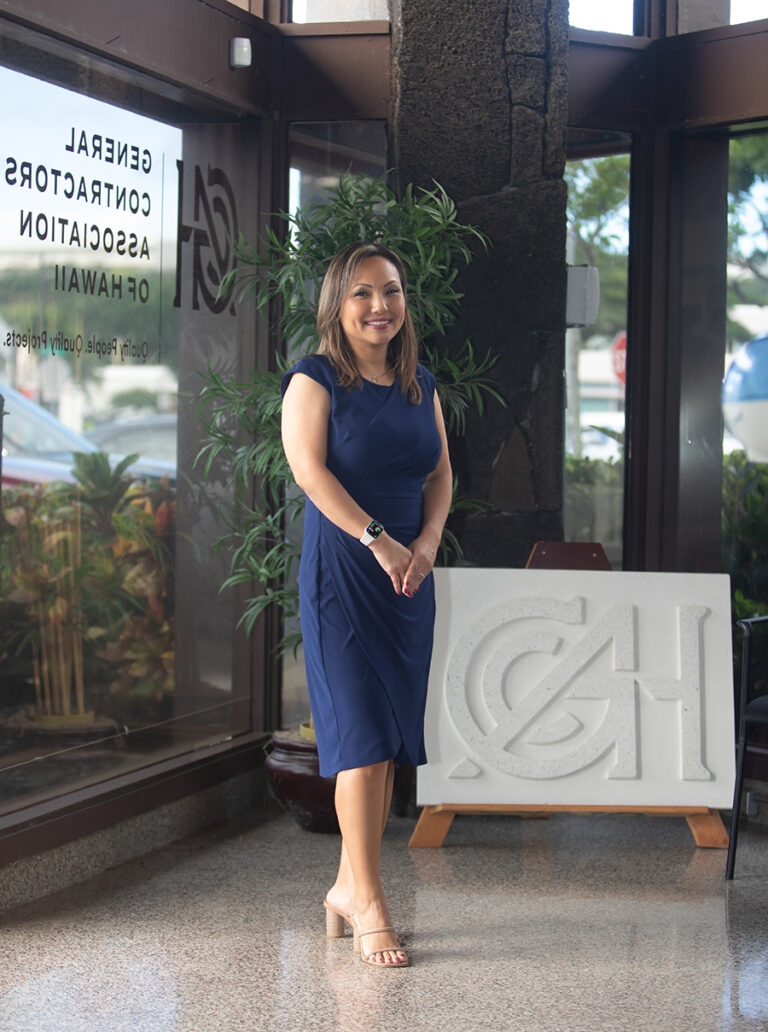
Cheryl Walthall PHOTO BY TONY GRILLO

Creatives and contractors bond at the 2023 U.S. CAD presents Designers v. Contractors THROWDOWN golf tournament. Left to right: Julia Fink, American Institute of Architects (AIA) Hawaii Chapter executive vice president; Steve Baginski, 2023 GCA president; Todd Hassler, 2023 AIA president; and Cheryl Walthall, GCA executive director. This year the American Council of Engineering Companies of Hawaii will compete in the renamed U.S. CAD presents BLUEPRINTS & BIRDIES Classic. PHOTO COURTESY GCA OF HAWAII
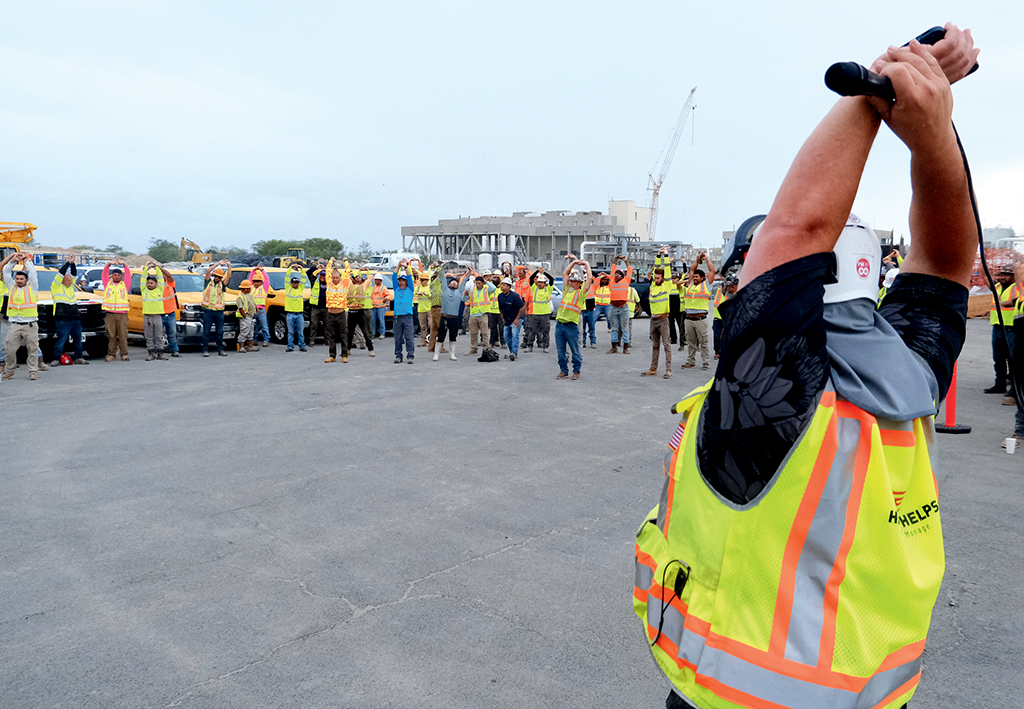
Tristan Aldeguer, Hensel Phelps senior safety manager, leads nearly 100 fellow employees in a group stretching session at the Sand Island Wastewater Treatment Plant during Construction Safety Week “safety stand-down,” May, 2023. PHOTO COURTESY GCA OF HAWAII
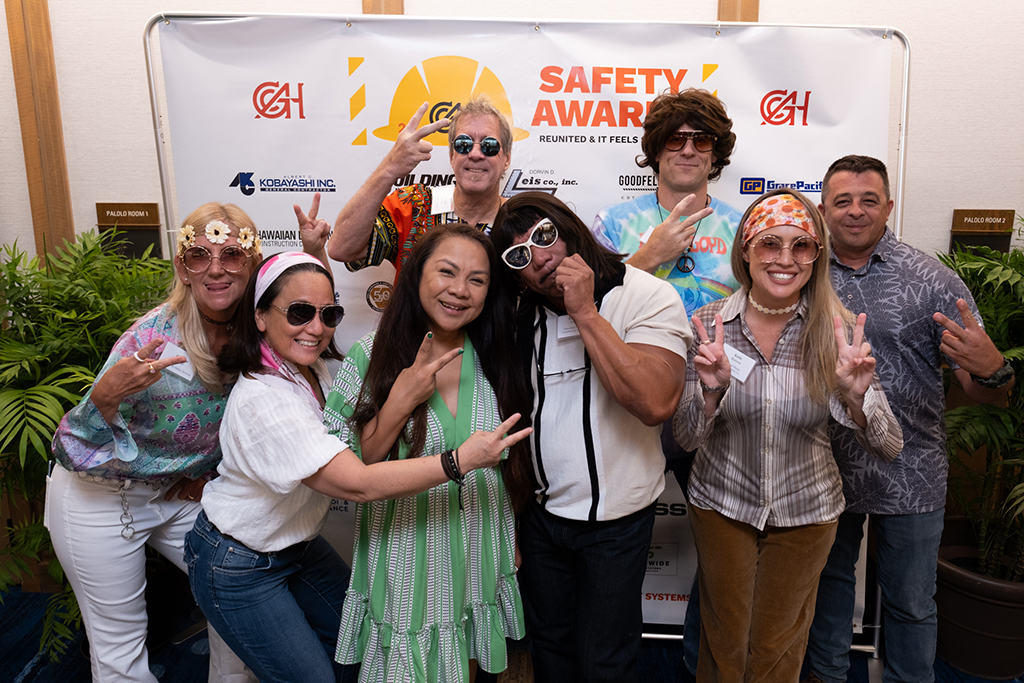
GCA’s annual Safety Awards recognize companies that have achieved a “Zero Incidence Rate,” meaning no workdays lost, or have an incidence rate 25 percent below each occupational division’s average. PHOTO COURTESY GCA OF HAWAII
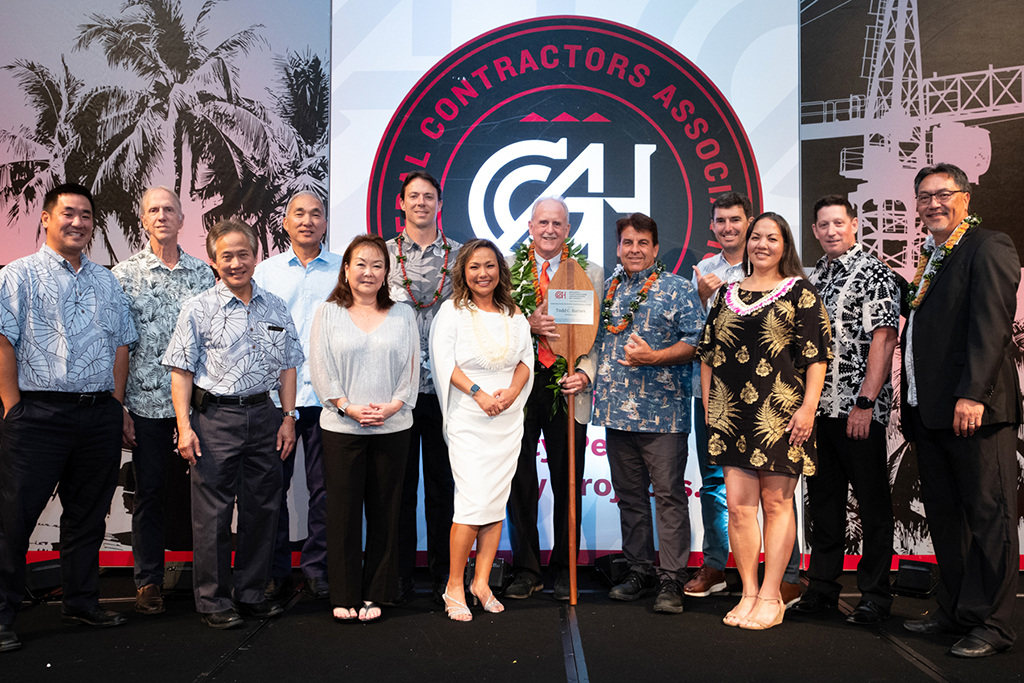
Hawaii industry leaders celebrate the state’s outstanding projects at GCA’s 2023 Build Hawaii Awards, where Kō‘ula at Ward Village, built by Hawaiian Dredging Construction Company Inc., was the Grand Award Winner. PHOTO COURTESY GCA OF HAWAII

